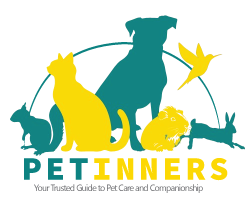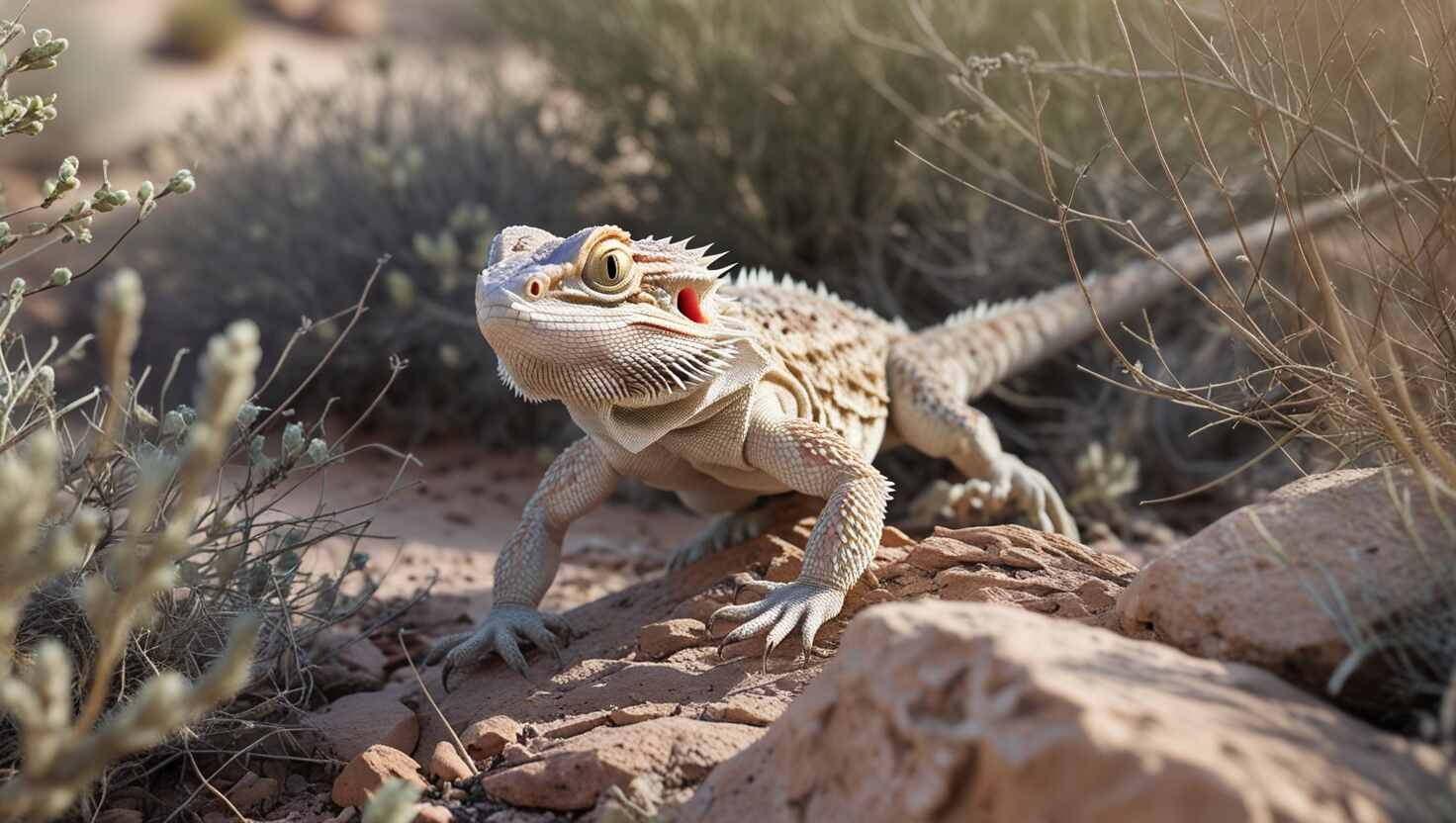Bearded dragon diet
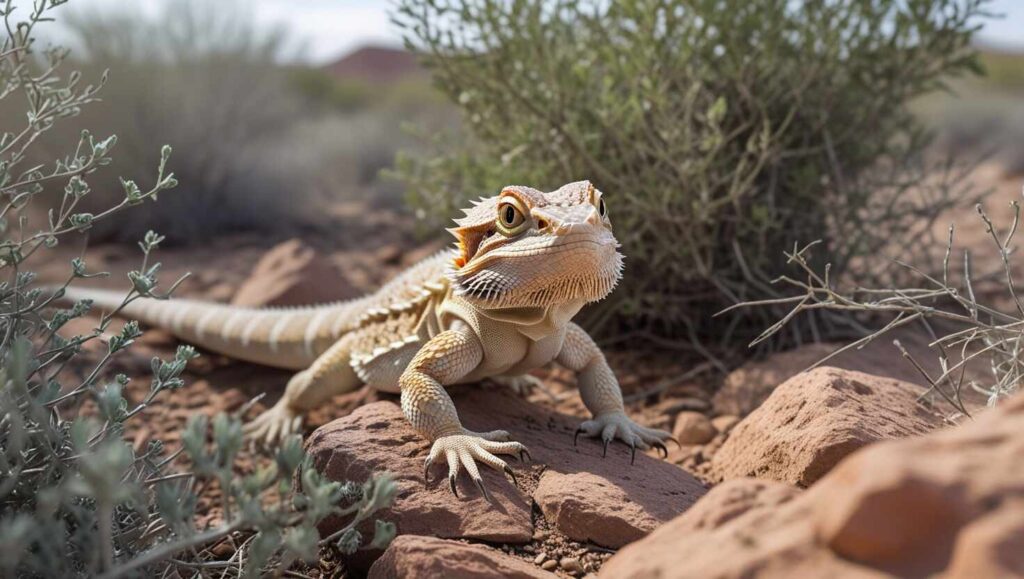
This article provides a complete guide to a bearded dragon’s diet, covering essential vegetables, fruits, live insects, and hydration tips. It explains age-based feeding schedules, supplements, and foods to avoid for optimal health. Special conditions like brumation and FAQs are also included for pet owners.
General Overview of Bearded Dragon Diet
Bearded dragons are omnivores, capable of adapting their diet to different conditions. In the wild, they might chase rodents and insects, showcasing behavior similar to carnivores, insectivores, or even herbivorous reptiles. Their natural habitat often includes sparse food sources, with activities like scurrying through bushes, climbing rocks, or burrowing to hunt. To stay healthy, beardies require a regulated feeding routine based on expert guidelines.
For juvenile and adult dragons, feeding recommendations include both animal-based and plant-based options. Offer live prey such as crickets, Dubia roaches, soldier fly larvae, hornworms, silkworms, mealworms, superworms, and occasional waxworms. Make sure these are gut-loaded and enhanced with fortified vitamins and minerals for proper nutrition.
Add non-citrus vegetables and nutrient-dense items to the mix. Photos courtesy of reptile experts like Gregory Rich, DVM, often show how beardies in large spaces thrive. They have big eyes and a sharp sense of smell, helping them identify value-packed foods. A balanced approach ensures they achieve optimal growth and prevents excessive fat buildup.
Age-Specific Feeding Guidelines
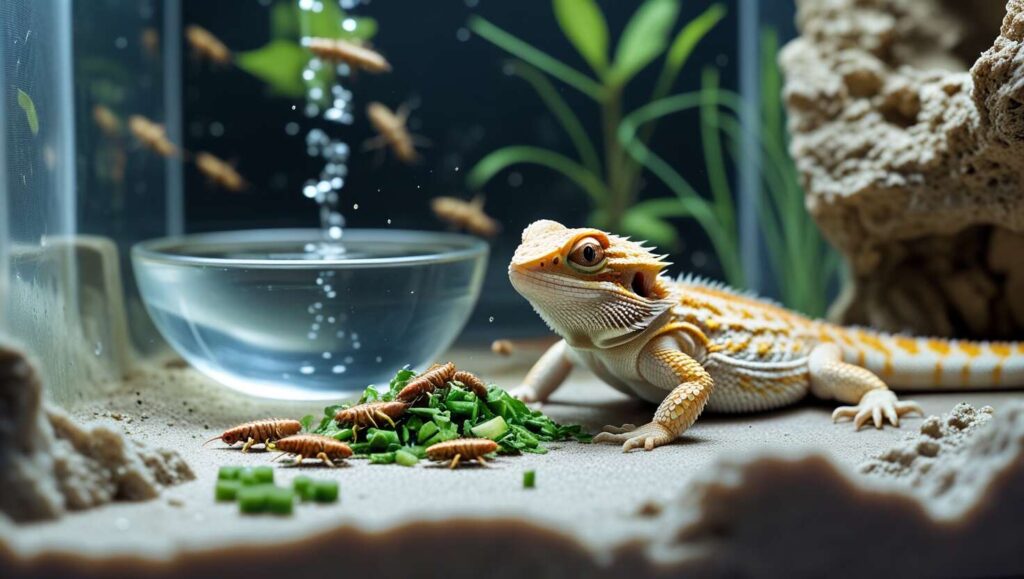
Baby Bearded Dragons
For hatchlings and juveniles, good feeding supports a strong growth rate. Here are key guidelines:
- Offer small, live insects like crickets multiple times a day.
- Use gut-loaded prey, dusted with multivitamin powder.
- Provide a finely chopped mixture of greens and veggies as part of the diet.
- Avoid using loose substrate in the tank, as dragons may accidentally ingest it, causing health risks.
- Limit feeding to ten to fifteen minutes per session. Remove any uneaten prey to prevent harm.
Adult Bearded Dragons
As beardies reach adulthood, their feeding habits change. To maintain good weight and prevent becoming obese, follow these steps:
- Provide a formulated diet with 70% vegetables and plant matter.
- Include fresh and varied options to prevent fussy eating.
- Offer nutrient-rich insects sparingly, ensuring they are gut-loaded and sprinkled with supplements.
- Avoid overfeeding, and clean out uneaten food from the cage.
- This balanced routine promotes your dragon’s quality of life and overall happiness.
Insects & Animal-Based Protein
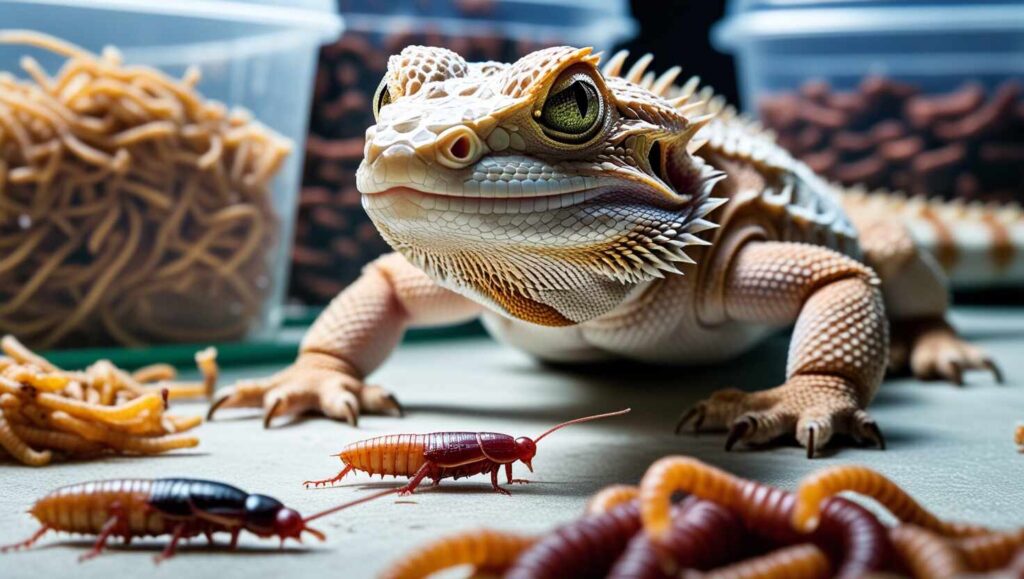
Safe Insect Choices
Bearded dragons need protein and calcium from animal-based food sources. They enjoy chasing live bugs like:
- Dubia roaches (nutritious, quiet, and low fat)
- Crickets (high protein, but can be irritating due to noise)
- Black soldier fly larvae, locusts, discoid roaches (good nutritional options)
- Superworms (offer sparingly to avoid excess fat)
Breeders and owners should avoid harmful insects like fireflies, elderbugs, or bait critters that carry parasites or pesticides.
Feeding Tips for Healthy Growth
- Use gut-loaded insects to enhance nutrients.
- Rinse feeders to remove particles and reduce risk of impaction, a fatal digestion issue.
- Remove uneaten prey to prevent phobias, panic, or infestation.
Feeding should be done in clean bowls, and extra foods like hydrating carrots, orange slices, or soaked pellets can add moisture.
Safe Plant Snacks
Offer lizard-safe plants such as:
- Basil
- oregano
- rosemary
- sage
- thyme
Edible flowers:
- dandelion
- daylilies
- impatiens
- carnations
- rose
Other:
- Mint
- clover
- leaves from maple trees
Insect Storage and Conditions
Store feeder insects in secure containers or aquariums to maintain a steady temperature and safe storage. These conditions help preserve insect health for balanced diet categories. Following these steps promotes overall pet health and happiness.
Vegetables, Fruits, and Plants
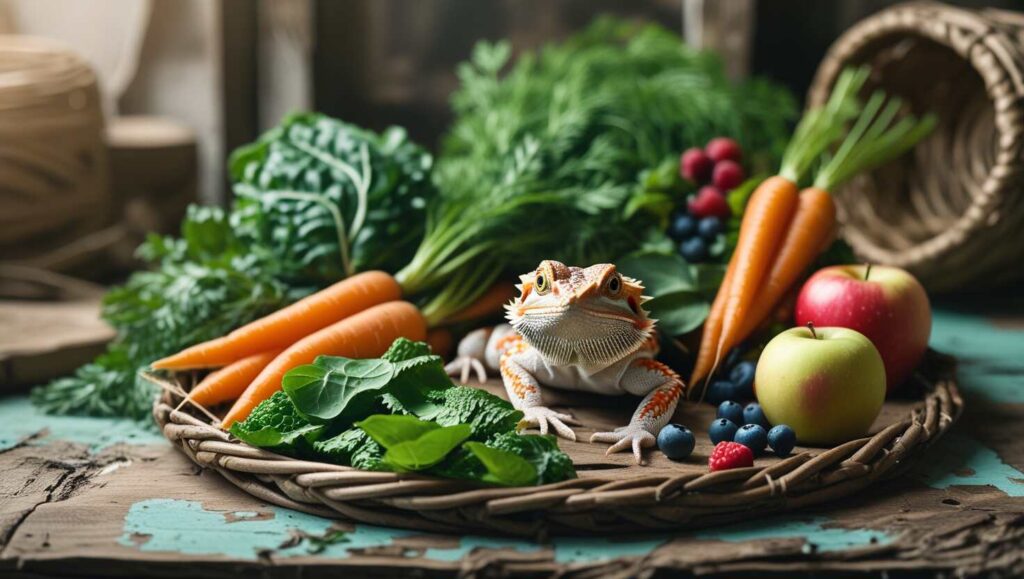
Safe Vegetables for Bearded Dragons
Daily feeding with a variety of veggies is essential for a balanced diet. Include both green leafy and colored vegetables:
Leafy greens:
- Collard greens ( Benefits of Collard Greens )
- kale
- mustard
- greens
- watercress
- arugula
- bok
- choy
- alfalfa
- Cilantro ( How to Serve Cilantro )
Colored veggies:
- Acorn squash
- butternut squash
- carrots ( Are Corrots a Good Choice? )
- cactus prickly pear
- bell peppers
- cucumber
- parsnip
- Tomatoes ( Can bearded dragons eat tomatoes )
Other options:
- Peas
- okra
- radishes
- spring mix
- artichoke heart
- sprouts
Avoid lettuce and rhubarb, which have little nutritive value and can block calcium absorption.
Fruits and Flowers
Use fruit as a savory snack, but in moderation. Safe fruits include:
Fruits:
- Apples
- mango
- papaya
- pears
- plum
- cranberries
- blackberries
- grapes ( Nutritional Considerations and Benefits of Grapes )
- kiwi
Flowers:
- Hibiscus
- dandelion
- roses
- nasturtiums
- carnations
Too many bananas, raisins, or dates can discourage calcium intake due to oxalates binding with minerals.
Preparation and Feeding Tips
- Wash all food thoroughly to remove pesticides and harmful residues.
- Offer finely chopped and mixed options in a shallow, clean dish to prevent food from being tipped over.
- Provide foods rich in trace minerals to maintain hydration and overall health under optimal conditions.
- Rotate food choices regularly to prevent issues caused by goitrogens, which affect thyroid function and can lead to hypothyroidism.
Foods and Plants to Avoid for Bearded Dragons
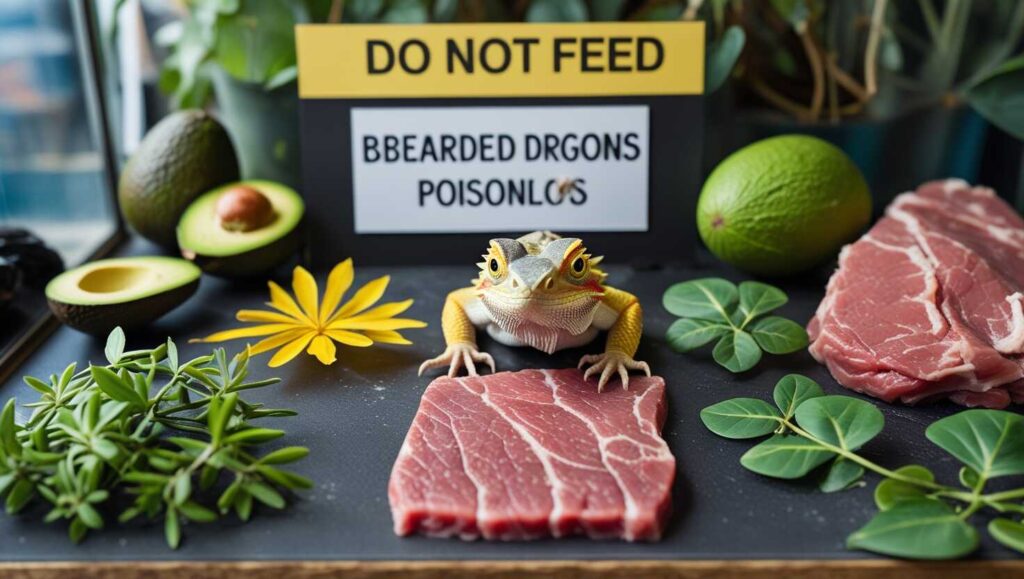
Harmful Foods
Certain foods are lethal, toxic, or unhealthy for bearded dragons. Avoid these foods:
- Avocados (high toxicity)
- Fireflies (glow-in-the-dark insects)
- Raw meat, including rabbit and eggs
- Commercial dog and cat food (designed for other animals)
- Wild insects (may carry parasites or pesticides)
- Lettuce (low in nutritional value)
- Spinach (binds calcium, making it difficult to digest)
Poisonous Plants
These unsafe plants can harm both birds and reptiles:
- Mistletoe, oak, holly, tulip, hemlock
- Boxwood, iris, sumac, poison ivy, jack-in-the-pulpit
- Daffodil, buttercup, elderberry, hydrangea, rhododendron
- Poinsettia, tobacco, juniper
Tips for Safe Feeding
- Provide diversity in their diet to meet nutritional needs.
- Ensure all produce is free of harmful chemicals.
- Proper hydration is essential, so offer fresh food and water regularly.
Supplements and Hydration
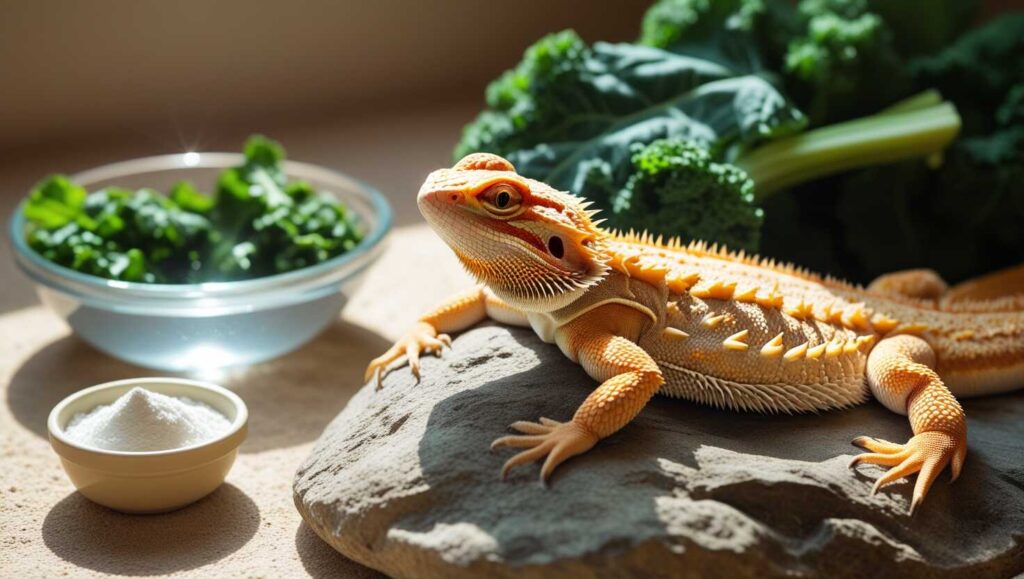
Importance of Supplements
Bearded dragons need calcium, vitamins, and minerals to prevent metabolic bone disease. Without proper D3 from natural sunlight or UV light, their bodies cannot absorb calcium effectively. Use phosphorus-free calcium powder like Rep-Cal to maintain a healthy calcium-to-phosphorus ratio. Prey insects should be dusted with powdered supplements before each meal. Multivitamin supplementation should only be given sporadically to prevent toxicity or overdose.
Hydration Tips
Hydration is vital in both hot and desert environments like the Australian habitat of dragons. Provide moist produce, such as leafy greens, to increase hydration. Offer a shallow, clean bowl of water for your pet to drink or soak in. In a dry climate, mist the cage in the early morning to simulate dew or light rainfall.
Feeding and Health Maintenance
For balanced dietary health, breeders and enthusiasts recommend sprinkling calcium over salads or other foods. Female dragons, especially gravid ones carrying eggs, may need a higher dose of supplements to support bone and development needs. Always follow your veterinarian’s recommendations to avoid illness from improper portions or inappropriate supplementation.
Feeding Schedule Based on Age
Bearded dragons require specific feeding schedules to ensure optimal nutrition:
- Hatchlings (under 3 months):
- Feed 3–5 times daily with small live, gut-loaded insects like crickets.
- Offer nutrient-dense greens and fruit to balance their diet.
- Juveniles (3 to 12 months):
- Feed twice daily with a combination of prey, vegetables, and fortified foods for nutritional value.
- Adults (12+ months):
- Provide one or two meals daily, with 70% salads and 30% prey.
Feeding Environment
- Place food in a clean dish inside the enclosure.
- Handle prey with tweezers if necessary.
- Ensure drinking water is available in a shallow bowl. Allow your dragon to soak occasionally to maintain hydration and humidity.
- Follow this healthy feeding guide to keep their appetite strong and growth well maintained.
Special Conditions
Brumation Period
In cooler months, bearded dragons in the wild enter brumation, a state where their metabolism slows due to lower temperatures and shorter day length. They may bury themselves underground in the darkest and coolest spots. During this time, they eat, drink, and move less.
Brumation in Captivity
In controlled environments, like captivity, dragons still follow their natural instinct. They may become unresponsive for weeks. While young dragons may not brumate, a veterinary check is essential if brumation is suspected to ensure their physical condition remains healthy. Always follow expert advice.
Frequently Asked Questions
How often do you feed a bearded dragon?
The feeding frequency depends on the life stage. Hatchlings eat several times a day, while an adult eats salad, vegetables, and prey 2–3 times a week.
Can I feed my bearded dragon dry food?
Yes, but only commercially formulated dry food. It should be part of a diverse diet with proper hydration to maintain balance.
Can bearded dragons eat scrambled eggs?
Yes, they can eat scrambled eggs for animal-based proteins, but only occasionally to prevent imbalances.
What do bearded dragons eat in the wild?
In the wild, they eat vegetation, fruit, leaves, and invertebrates like ants and beetles. They may also catch small lizards.
Can bearded dragons eat apples?
Yes, apples are safe if peeled, cut, and served without the stalk.
Can bearded dragons eat blueberries?
Yes, offer fresh, washed blueberries without preservatives or pesticides.
Can bearded dragons eat broccoli?
Yes, but only in small amounts. Avoid overfeeding raw or cooked broccoli, as it can make them sick.
Kindly note: The content shared in this blog is gathered from online sources, some of which may not be verified. For accurate guidance on caring for your Bearded dragons, it is recommended to seek advice from a qualified veterinarian.
